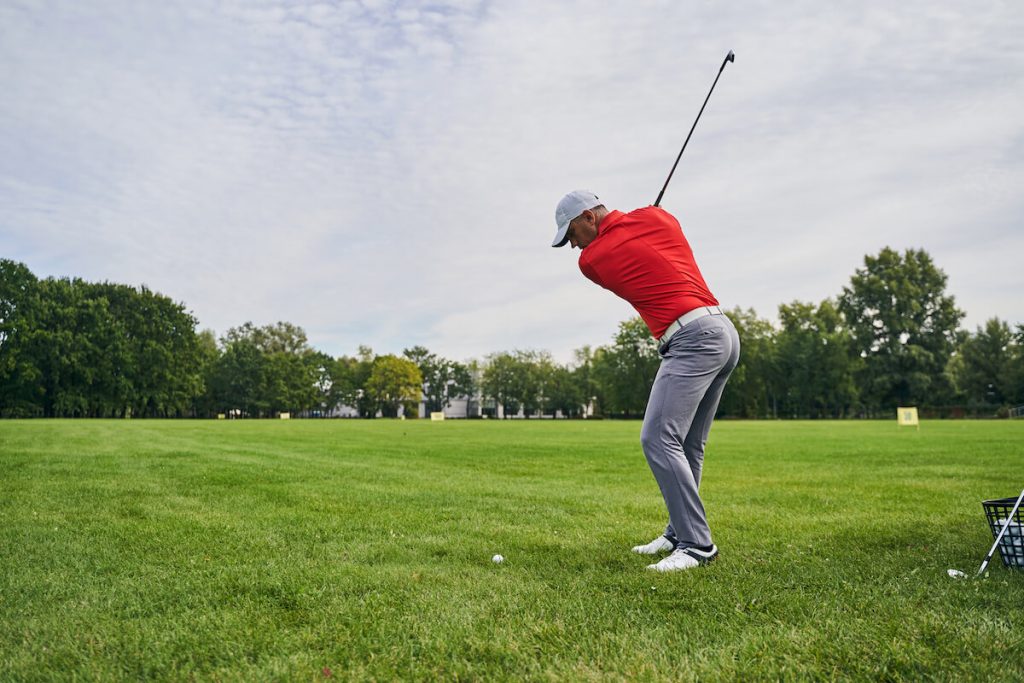Looking for some useful guides on “how to shallow golf swing” and find the appropriate plane on the downswing? Mastering how to shallow begins by having a deeper grasp of your golf swing sequence.
You can shallow your swing by concentrating mainly on your lead wrist and weight shift during the downswing.
Use your wrists and trail arms to move the club shaft from a lifted stance to a shallow stance. Remember, you need to execute this technique more horizontal to the ground.
Afterward, turn your wrists at the top of the swing and drop your trail arm. Doing so allows the golf club to undertake a shallower stance.
Executing this technique will let your shaft angle improve naturally. Consider reading more about the post below for more detailed steps.
What Is A Shallow Golf Swing?

A shallow golf swing means getting the club plane in a more horizontal stance when you downswing.
A shallower swing allows you to improve your ability to hit the ball, resulting in straighter and longer shots.
Steps to Shallow a Golf Swing

Step 1: Relax your right arm
Instead of stiffening your right arm, try to relax it to attain increased flex on your backswing. Stiffening your right arm produces a steeper attack angle, obstructing your shot.
Softening your right arm allows you to put the club in a better stance, enabling rotation to direct your clubhead. At the same time, it can lead to a gradual path to the ball.
Step 2: Move your hands inwards
Take the clubhead in and around your body. Performing this movement does a great job of enabling a shallower downswing.
Step 3: Do ultimate hip rotation
Hip rotation is essential to ensure an exceptionally shallow golf swing. It allows you to produce maximum power during your downswing and backswing.
Apart from that, hip rotation directs you through the shot. Lack of adequate hip rotation averts dropping the club into a shallow stance, at the top of the downswing.
Step 4: Shallow the shaft
Getting the shaft into a shallow stance, at the top of the downswing isn’t easy. So, when you experience this difficulty, consider positioning your clubhead behind your back.
Sufficient hip rotation works wonders in dropping the clubhead to a preferred stance before being directed to the ball.
Step 5: Incline your trailside
Incline your trail leg toward your front leg as you start the downswing. Aside from instituting a vigorous leg drive, doing so can result in attaining maximum distance.
This technique also lets you get the clubhead into the appropriate stance.
Why Is shallowing Golf Swing Essential?
Shallowing your golf swing is paramount because it offers more compression on your wedges and irons.
Golfers need to learn how to shallow their golf swing to ensure more consistent contact, and straighter and longer drives.
Additionally, you must shallow your swing to enjoy a more compact and quieter golf swing.
Steep swings hinder your golf experience; therefore, eliminating them can make a significant improvement in your game.
Golf Pointers And Practices To Shallow Your Golf Swing

Use an alignment stick
This training tool works like a charm in attaining a shallower swing. Position the alignment stick at a 45-degree angle, on the ground. Be sure to avoid making contact with this training aid when swinging.
Place your club on top of your swing; from there, gradually glide it beneath the alignment stick. Keep practicing until you feel comfortable taking a real swing.
Using an alignment stick helps you instantly know whether you’re shallow enough when swinging.
Improve your tempo
It’s fundamental to slow down during your swing; hence, you need to practice your tempo. Being adept at making consistent contact with the ball allows your body and club to execute the task more naturally.
Target having a nice and easy tempo and maintaining a pause at the top of your swing when practicing. In particular, pause at the top of your swing between your downswing and backswing.
This method lets your hips energized, produce more power, and place your club in a shallower stance.
Read more: How To Practice Golf In The Backyard (17 Ways)
Try the wall drill
You can easily accomplish this drill with the help of your golf club and a wall.
This practice offers instant and live feedback about your swing. It determines if your swing is too steep and lets you drive your hips at the start of the downswing.
Top-of-the-line Training Aids For Shallowing The Golf Club
Chiliwacker Golf Swing Training Aid
This training tool lets you organize foam guides that coordinate your swing on the appropriate plane.
Supposed you hit the foam guides, this means you went over the plane, signaling you to modify your swing correspondingly.
The best thing about using the Chiliwacker training aid is that it helps avoid damaging your club.
Shaun Webb Golf Alignment Sticks
Alignment sticks are effective, simple to use, and less expensive, making them the ideal choice for amateurs.
Simply set up these golf alignment sticks behind and outside the line of your club shaft. Be sure that you don’t make contact with the alignment stick during a swing.
TuhooMall Magnetic Golf Club Alignment Stick
To get started, fasten these magnetic alignment sticks to your clubface. Doing so can help you determine where your club is directed at impact, with a few moderate swings.
Using this training aid offers quick and effective feedback, giving you signals to modify your swing.
FAQ’s
Flattening the club in your backswing can remarkably help shallow the club and hit the ball further.
Indeed, you can enjoy a more straightforward coil and release if you put the club in a horizontal stance.
It’s worth noting that this technique is ideal for averting slices that move far less distance than draws. In the same way, it excels at maintaining swing speed.
No. You’re likely to encounter a few drawbacks if your swing is too flat. A too shallow swing can lead to shots pushed way right, unpleasant and ruinous duck hooks, and balls struck neighboring the club’s sole.
Consider using your wrists and trail arm when moving the club shaft from a high stance to a flat stance. Please note that you must do so in a more horizontal position to the ground.
Hinge your wrists at the top of the swing and drop your trail arm when doing this technique. Doing so will propel the club to fall into a shallower stance.
It’s imperative to use your lower body consisting of your slower and larger muscles when you downswing.
This conveys that you need to ensure your legs maneuver slower than your arms. There’s a possibility of slicing or hooking the ball if your arms get out in front of your legs.
That said, you must perform your downswing with a weight shift through your lower body.
The answer to this question depends on certain factors because every golfer has natural tendencies.
But, generally speaking, a shallow swing doesn’t give you a hard time keeping it on the plane.
It’s undeniable that keeping your swing on a plane all the time gives you better chances of getting consistent shots.
Difficulty shifting the weight of your trail leg to the front and a pretty shallow swing is troubling.
Due to these, there’s a possibility of linking the ball with your weight trailing the clubhead.
Unfortunately, this stance provokes you to leave the clubface open at impact, leading to a push or slice.
You’re unlikely to shallow your swing because of a stiff takeaway or grip that’s pretty distant on the inside.
A stiff grip keeps you from executing the needed wrist adjustments at the top of the swing.
Similarly, an inner takeaway will compel your backswing to be excessively shallow, which means shallowing more can fire up hooks.
Final Thoughts
You can level up your game experience with the help of some golf tips, training aids, and drills.
If you’re aiming to hit excellent golf shots, you need to concentrate on mastering the steps to shallow your swing.
As discussed, shallowing is a valuable component of the golf swing; however, it’s often neglected and challenging to learn.
It’s fundamental to concentrate on your lead wrist and weight shift during the downswing to gain a shallower shaft angle.
Consider practicing more often to reach your desired result. Hopefully, our post about how to shallow golf swing can better help you improve your golf shots.
Please feel free to share this article with other readers!
Read more: How To Travel With Golf Clubs?
Matt Stevens is the founder of Golfrough.com. He holds a Postgraduate in Sports Marketing and has played golf since he was four years old. Having experienced every high and low golf has to offer, his writing helps the average golfer avoid the mistakes he has made in 28-years on the course.

